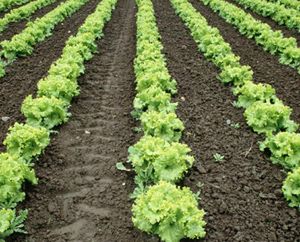Cold Crop Quick Facts – Cold-Season Vegetables at Gertens
Looking for cold crop quick facts? Here at Gertens, we have information on how to plant and when to harvest cold-season vegetables.
WHAT IS A ‘COLD CROP’?
Cold Crops are vegetables that thrive in cold or cool weather. Whereas warm-season crops will usually be killed by frost. Cold crops can be planted before the threat of frost has passed. In fact, many cold crops will ‘bolt’ or produce unwanted flowers in the heat of summer, causing a bitter flavor to the foliage.
All of the cold crops—cabbage, broccoli, kohlrabi, cauliflower, and more—that we grow at Gertens are direct seeded into jumbo 606 pacs. We sow four seeds into each cell of the pac (24 seeds/pac) to ensure that each cell has a plant in it. This is also the case for the sweet Spanish yellow and white onions, lettuce and arugula.
Below is a list of cold-season crops carried at Gertens in 6-pack flats or plug trays.
BROCCOLI ‘PREMIUM CROP’
Broccoli plants grow upright, often reaching a height of 2 1/2 feet. Plant 24 inches apart, with 36 inches between rows. Green buds develop first in one large central head and later in several smaller side shoots. Broccoli can usually be harvested for several weeks. Fertilize at planting and again when the plants are half grown. Provide ample soil moisture, especially when heads are forming.
BRUSSELS SPROUTS ‘JADE CROSS’
Brussels sprouts are hardy, slow-growing, long-season vegetables. Sprouts improve in quality and grow best during cool or even lightly frosty weather. When planting, place plants 24 inches apart. The small sprouts or buds form heads one to two inches in diameter. They may be picked (or cut) off the stem. Fertilize at planting and again half way through the season. Water regularly to keep the crop growing vigorously during the heat of summer.
 |
CABBAGE
Cabbage is great eaten steamed or boiled. It is also commonly used in cole slaw. Space plants 12 to 24 inches apart in the row. Ample soil moisture is necessary. Protect young plants from direct sun. Plants will mature in about 70 days from transplanting. Cut the cabbage heads when solid (firm to hand pressure) but before they crack or split.
‘SAVOY ACE’ CABBAGE – produces a dense blue-green head, weighing up to 3 1/2 pounds! Perfect for a small family meal.
‘EARLY RED ACRE’ CABBAGE – a top-notch red variety used raw, cooked or in coleslaw. Heads are deep red, globe shaped, 6 to 7 inches in diameter.
CAULIFLOWER
Cauliflower should be planted early enough that it matures before the heat of the summer, but not so early that it is injured by the cold. Space plants 18 to 24 inches apart in the row. Cauliflower must have a consistent and ample supply of soil moisture. When the head shows 2 to 3 inches of white curd, tie the outer leaves together over the center of the plant. From then, it is ready to harvest within 7 to 12 days.
‘SYMPHONY’ CAULIFLOWER – a premier variety that produces high-quality, very dense white heads with tight protective inner wraps.
‘GRAFFITI’ CAULIFLOWER– an ornamental variety that produces very dense, ornamental purple-red heads that keep their color even after cooking! Needs less wrapper protection than other varieties.
KALE
Packed with vitamins and minerals, Kale has been cultivated for culinary purposes since ancient Greece and is among the easiest vegetables to grow. Plant in a sunny location. Use kale in soups and vegetarian main dishes.
KOHLRABI ‘GRAND DUKE’
Kohlrabi is very easy to grow, producing high yields in limited space. The edible portion is a rounded, enlarged stem section growing just above the soil line. Kohlrabi can be transplanted into the garden as soon as the ground becomes workable. Like cabbage, kohlrabi can stand some frost. Place 5" apart. Begin harvesting (pull or cut at ground level) when the first stems are about one inch in diameter.
 |
LETTUCE
Lettuce is best planted early, before hot weather arrives, as hot weather will cause the leaves to become bitter. Harvest outer leaves as soon as they are large enough for use. A second fall crop can be planted indoors around July 15 and outside August 10. With a mild fall, lettuce can be grown until Thanksgiving!
SWISS CHARD ‘GARDEN LEADER’
Swiss Chard belongs to the same family as beets and spinach. It has the bitterness of beet greens and the slightly salty flavor of spinach leaves. While both the leaves and stalk of swiss chard are edible, the stems vary in texture with the white ones being the most tender. Besides its culinary value, Swiss Chard can also be grown simply for its ornamental fan-like leaves with white, red, or yellow stems and midveins.
STRAWBERRY ‘FRAGOO’
Nothing compares to a vine-ripened strawberry! This everbearing selection produces large yields of sweet fruit in June and many months afterwards. Plants are very tolerant of cold and frost. ‘Fragoo’ is a perfect Strawberry variety for desserts, juices, jams, garnishes and syrups. Plant in full sun.
